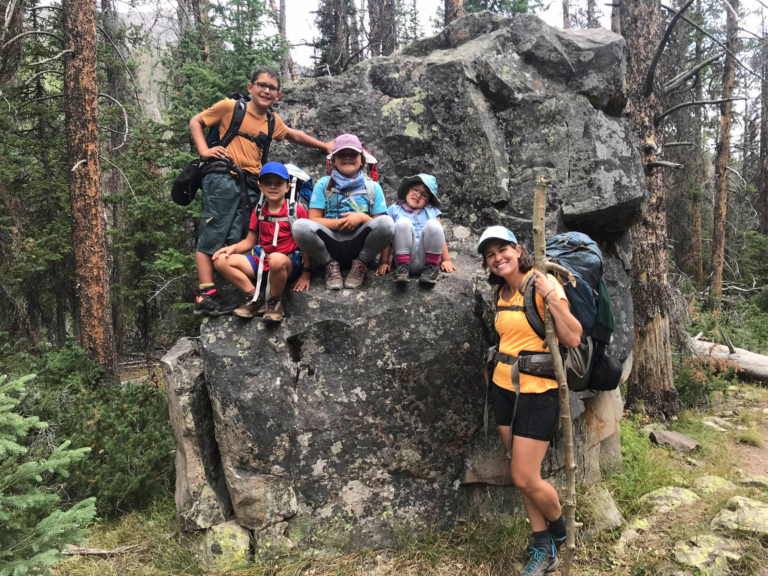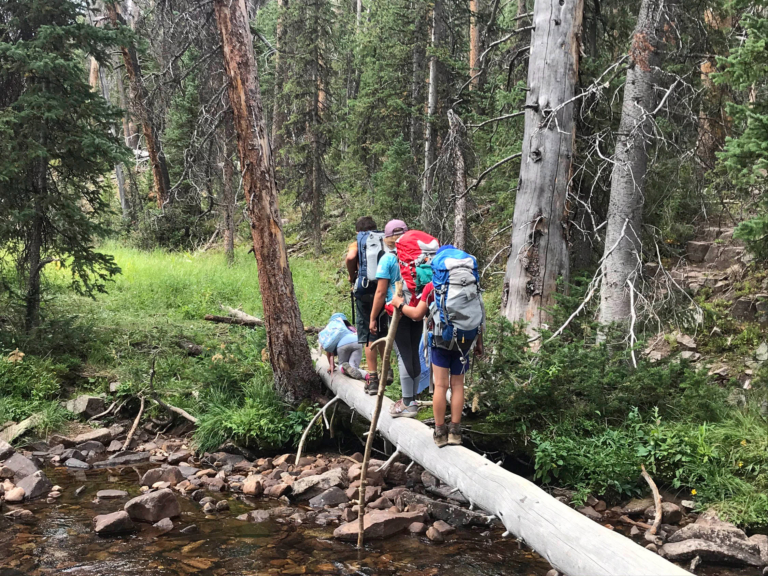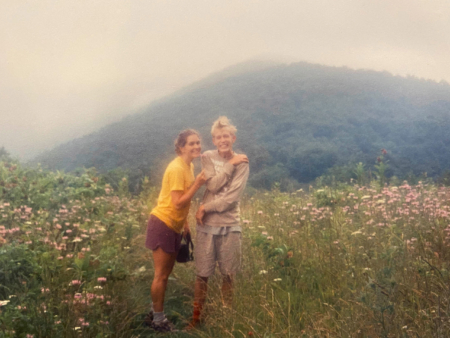From the AT to NYC
All photos courtesy of Britney Caceres
Britney Caceres was 15 and a little surprised when her parents dropped her off along the Appalachian Trail (AT) with her brothers and promised to pick them up three days—and 50 miles—later. She didn’t know it at the time, but this walk in the woods would shape the way she’s raising her kids in Manhattan.
Britney was raised in the shadow of West Virginia’s Blue Ridge Mountains, where she spent much of her childhood climbing trees and scrambling up riverbanks with her three younger brothers. But even though her home was in the middle of one of the nation’s most inspiring landscapes, her family wasn’t overly inclined toward backpacking. The one time her parents took the kids camping—out of obligation, she suspects, given their environment—their tinfoil dinners fell in the fire and they subsisted on Pop-Tarts instead.
Even so, Britney caught the outdoor bug young. She was influenced heavily by her second-grade teacher, who told the class stories about living in a tent with her family and for Christmas one year gave the class copies of a book called 50 Simple Things You Can Do to Save the Earth. “She just made me very aware of the environmental movement and how it was important for us to be aware of the environment and take care of the Earth,” Britney explains.
This burgeoning concern for the environment dovetailed nicely with Britney’s surroundings. She spent a lot of time outside with her brothers and a family friend’s five boys. “My parents always kind of had what they call a ‘free-range’ parenting style,” she says. “I had this upbringing that was very free and very nature-oriented.” Being the only girl was never a problem for Britney, but it did have its setbacks. She watched with envy as her younger brothers and family friends all became Boy Scouts and learned essential skills, like how to filter water and start a campfire. She craved those experiences, too, and tried to join them whenever she could—even if it just meant showing up in the morning while they were cooking breakfast at camp. “I was super persistent,” she says. “I was like, ‘I want to do that. Why can’t I?’” She made it a point to learn every skill the boys learned as Scouts.
The idea for hiking the AT came from her family’s friends, who did the planning and dealt with the logistics; Britney and her brothers went along for the ride. The Scouting skills paid off, and by the time they were too far from the trailhead to turn back, they could take care of themselves, albeit in a somewhat ragtag fashion. “Our backpacks were probably old packs scavenged from other people,” she says. For self-defense, one of her brothers brought a golf club. “We weren’t experienced backpackers,” she says. “We were just kids out on the trail, putting in the miles.”
But they knew how to use a map to locate water sources. They could cook meals, make camp and break it down. For Britney, realizing they could manage outdoors on their own was empowering. Fifty miles over three days is no minor feat, and those days on the trail taught Britney to trust her own judgment and persevere when things got tough.
Her love for the outdoors never waned. She studied fisheries and aquatic sciences in college, with the goal of working for the US Forest Service or Fish and Wildlife Service. When she graduated, she moved to New York City for a teaching fellowship program, assuming it would be temporary. But her plans changed when she began dating the man who is now her husband, a committed New Yorker. The two settled in Manhattan, which Britney admits was initially hard. She’d go months without venturing into nature. “I really did feel like I kind of lost a piece of myself when I moved to the city,” she says.
When she was pregnant with their first child, they moved to an apartment two blocks from Central Park. As the family grew—the Caceres now have four kids ranging in age from 4 to 11—the park became more than a respite from city life, serving as an indispensable connection to the outdoors. Britney even started teaching classes for children in the park, so that kids as young as 18 months old could learn the value of romping around in nature and getting dirty. “We live in a two-bedroom apartment with four kids, but we can’t move away because we’re two blocks from the park,” Britney says, laughing. “That’s worth so much more than a bigger apartment.”

Hiking trips like last summer’s escape to the Uintas in Utah feed this city-family’s hunger for nature. From left to right: Ezra (11), Leo (7), Lucia (9), Isa (4) and Britney.

The family that crosses fallen-tree bridges together, has more fun together. Another moment from last year’s adventures in the Uintas in Utah. From front to back, Isa, Ezra, Lucia and Leo.
When she takes her kids to the park, it feels like being in the wild. The park’s North Woods are made up of 40 acres of trees, waterfalls, rock formations and all manner of flora and fauna. During the pandemic, while the city was locked down, her kids picked up an interest in birding and can identify several species that inhabit the park, like the tufted titmouse and chickadees.
To Britney, raising kids in the city means she has to work a little harder to ensure that they learn the same lessons from the outdoors that she did. Now that her son is in middle school, Britney feels comfortable letting him and his 9-year-old sister explore the park on their own.
Britney says she’s learned that it’s not necessary to live in the backwoods to reap the benefits of nature. While she’s totally open to the idea of letting her kids embark on the Appalachian Trail as she once did, she feels it’s more important that they’re learning their place in the natural world, and the importance of being stewards to the earth.
“If they’ve spent time in the forest and they’ve spent time in the desert and they have memories and connections with the land, then they’re going to feel more of a desire to protect it and preserve it for the future,” she says. “Outside is a good place to find that. And you can find that anywhere—even if that starts in a city park.”

